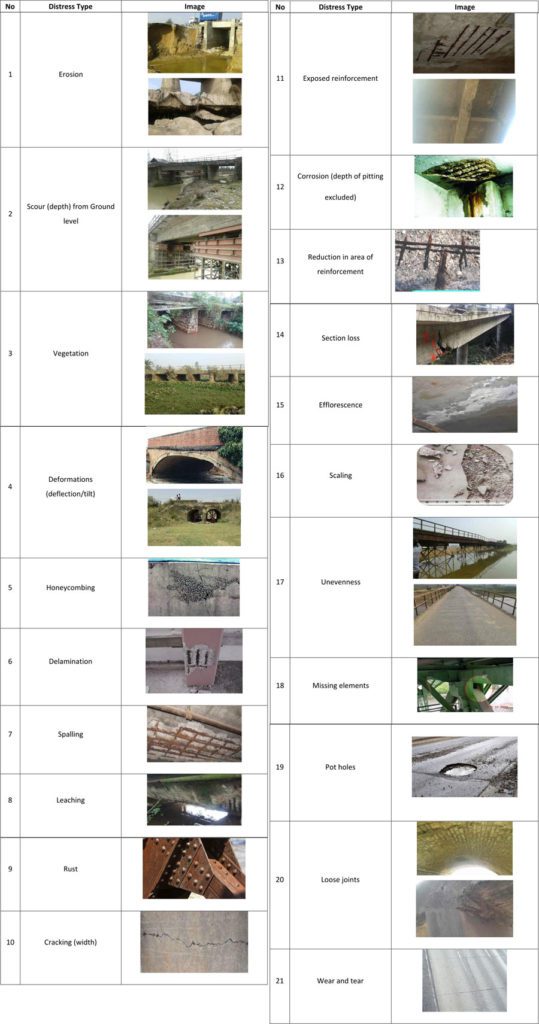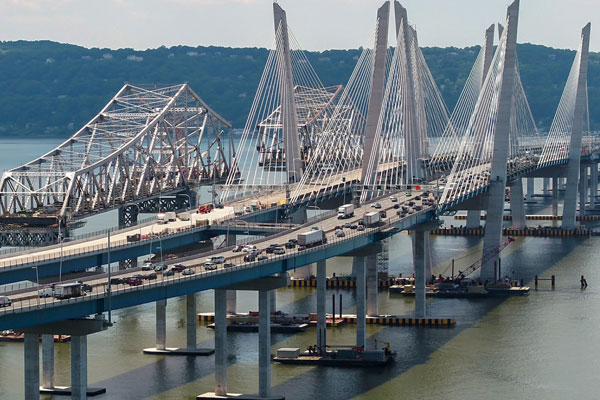Since the start of development of Unified Bridge Management System (UBMS) the focus was on consolidation of internal quality assurance protocol within the IBMS (Indian Bridge Management system). This has resulted in the inclusion of validation of all inputs on which the decision making in management of bridge is dependent. The validation process is either mandatory confirmation of inputs in previous activity (ratings in inventory are confirmed by Bridge inspectors during inspection process) or incorporation of inputs to substantiate the data available for decision making. The introduction of Cause Matrix which substantiates the data provided by structural ratings by identifying the reason of deterioration results in one additional data point to base your decision.
UBMS uses historical data generated by structural ratings and Cause Matrix rating to generate possible deterioration vs time maps for that particular bridge. Such equations form the basis for the deterioration model for that bridge.
Deterioration model identifies the risk of NO ACTION and thereby provides important inputs for the most efficient time for remedial intervention on a bridge. This decision is based on changes in both Structural ratings and Cause Matrix ratings.
UBMS decision making follows the dictum of “FRWD” (First Repair Worst Damage) to attend to all bridges in the initial cycle till such a time when all bridges in the network show increase in structural ratings and then the focus shifts to “RAFS” (Repair at first symptom) to bring in efficiency in the network management.
CONSOLIDATION OF DATA COLLECTION PROCESS:
UBMS or for that matter any Bridge Management System (BMS) relies for its decision making, on the reliability of data input during the inventory and inspection process when the ratings for structural components are assigned. World over, it is now an accepted fact that this input is hardly reliable and its correctness is at best 60%, when the inspectors are trained and accredited personal. Within UBMS we have included an additional level of input, wherein the data undergoes one confirmation sub routine wherein Ratings given during inventory are confirmed by Bridge Inspectors (Who are generally more experienced and have the expertise essential to define distress in bridge) during the inspection process. This results in increased authenticity of Inventory Rating data. The Cause matrix that the inspector generates is validated during the testing process by the testing agency based on acceptance of prognosis or rejection of prognosis evolved during inspection which enable the bridge inspector to assign the cause matrix ratings to the bridge. Such confirmation of cause matrix ratings ensures that all rating data used for further analysis during deterioration modelling, risk analysis, ranking and priority module are all pre- validated data at multiple levels. Such consolidation of data is the key to increased authenticity of UBMS results.
MULTIPLE PARAMETER DEPENDENCY
UBMS has three basic inventory rating inputs; namely
- Bridge Structural Rating Number
- Bridge Functional Rating Number
- Bridge Socio-Economic Rating Number.
Such multiple parameter inputs ensure that the ratings given to the bridge cover all important parameters of the bridge. It is generally observed by researchers that Structural service life of the bridge (that is designed for) is much more than Functional service life; which is not accounted for anywhere during design. Design service life (structural) will be now 100 years for all bridges designed post 2015 and previously it could be between 50 and 100 years. However, the Functional service of any bridge cannot be more than 30 years due to an increase in Average daily traffic (ADT) on the bridge, its bridge width (number of lanes), Load capacity of the bridge. Also, the importance of the bridge changes with time and so the Socio- Economic importance can never be the same for the entire Structural service life. These realities within the life cycle of the bridge makes it important to consider all three factors when decision making is involved. Apart from the above three parameters, the reason why the bridge deteriorates also dictates how the bridge will deteriorate with time and hence the importance of Cause Matrix ratings in UBMS. When the decision is to be made on the network level, the inventory ratings are critical. The ratio in which they individually influence the decision making can be a subject of more research, but their influence cannot be doubted. Similarly, the importance of cause matrix ratings to decide the type of remedial intervention, for any individual bridge, cannot be disputed.
DISTRESS AND DETERIORATION
Distress in bridge is dependent on various factors apart from the material of construction and design philosophy. These two factors are which human beings can reform and control over time with the increase in knowledge base. But factors like increase in ADT, increase in overall loads to be transferred, environmental impact, sudden climatic variations, natural calamities are probably beyond human control and the impact of these factors affect the bridge during their service life. The impact of all the above factors lead to distress in bridges which manifests into a deterioration process. Common distress symptoms are enumerated in Table below.
Some General Type of Distress found in Bridges.

MANAGEMENT OF BRIDGES IN UBMS
UBMS is a system that needs data collection to be year on year, at times twice every year. Such historical data generated within the UBMS database is the backbone of all decision making. The periodic data created by structural ratings, functional ratings and socio-economic ratings are used to generate the possible list of candidate bridges that needs further attention in the network. Financial constraints are a guiding factor on the number of bridges within a network to be provided with remedial intervention. This constraint brings in the necessity of priority and ranking of bridges that will be undertaken for remedial action. For any bridge with distress, it is possible to generate a deterioration model which can estimate the duration of time for which the bridge can survive without any remedial intervention. Structural ratings and Cause Matrix rating for that bridge are used to generate possible deterioration vs time equations for that particular bridge. Such equations form the basis for the deterioration model for that bridge. Such a deterioration model can also estimate the addition in cost in subsequent years if no action is taken on the bridge. The trade-off between taking immediate action under budgetary constraints and addition cost to be incurred if remedial interventions are delayed to a future point in time decides the level of risk that the distress creates. Deterioration model identifies the risk of “No action” and thereby provides important inputs for the most efficient time for remedial intervention on a bridge. This decision is based on changes in both Structural ratings and Cause Matrix ratings with respect to time which the deterioration model estimates.
RANKING AND PRIORITY
Bridge management is being used for the first time in India and as such, not many bridges have undergone repairs or rehabilitation interventions, unless the symptoms had been alarming and obvious threat to safety of the structure. The world average for bridges in distress is above 25% and at times going as high as 40%. Indian scenario could not be different from the world scenario. To ensure that all bridges are brought to safe limits of acceptance was the first objective of BMS and to address that objective, UBMS decision making follows the dictum of “FRWD” (First Repair Worst Damage). Such a philosophy ensures that all bridges with maximum and severe distress would be attended to first and each year, more such bridges would migrate from unsafe zone to safe zone. As more and more bridges move to safe zone, the need to adopt FRWD would diminish and then the focus of UBMS will be to maintain all bridges in safe zone by ensuring that structural ratings would be above 5 and start to move to 6 plus with time by ensuring that even the slightest of distress is attended to. The principle used would shift from FRWD to RAFS (Repair at First Symptom). This would result in even the smallest of structural distress being attended to. Functional deficiency many times get eradicated only on reconstruction. UBMS uses cause matrix to identify distress and that ensures that distress is eradicated by removing the cause of the distress. Cause matrix ratings enable UBMS to apply both FRWD and RAFS equally efficiently.
CONCLUSION
UBMS is a very efficient system that relies on multiple parameters to identify the bridges on any network that are in need of repair. All such bridges identified for repair interventions are inspected, first to confirm the ratings given in the inventory are correct and then to generate the prognosis and cause matrix ratings. These ratings enable UBMS to create deterioration model for the type of distress that the bridge is undergoing thereby ensuring that the model accounts for the unique type of distress on the bridge under the given environmental conditions. The prognosis is confirmed by testing the bridge. Risks involved in case of No Action is typically based on the type of deterioration and environment and geography of the bridge. UBMS ensure all these factors are accounted for. Such multilevel confirmation of inputs ensures that UBMS uses data that is reliable and authentic. Reliable and authentic data ensures higher efficiency in decision making under UBMS.
About the author:

The article is authored by SACHIDANAND JOSHI, Emeritus Chair—IBMS @ IDDC Engineers Pvt. Ltd.
All of the author’s career has been devoted to the Rehabilitation of structures. He has been a team leader to over 2000 inspection, repair and rehabilitation projects. Having seen the various causes of distress so closely and the extent of damage and loss that is caused by ZERO maintenance of various structures, he decided to devote his energy to conceptualize a system that can avoid this scenario. From that urge to minimize distress, came his focus on Asset Management Program.
SACHIDANAND JOSHI is presently working passionately to implement Asset Management Programs in various facades of the Civil Engineering industry in India. The author has ha flair to conceptualize projects and get the team to complete the micro-planning.

